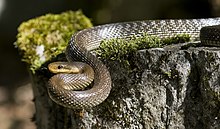| Aesculapian snake | |
|---|---|

| |
| Adult Z. longissimus from the region of Ticino, Switzerland. | |
| Scientific classification | |
| Domain: | Eukaryota |
| Kingdom: | Animalia |
| Phylum: | Chordata |
| Class: | Reptilia |
| Order: | Squamata |
| Suborder: | Serpentes |
| Family: | Colubridae |
| Genus: | Zamenis |
| Species: | Z. longissimus
|
| Binomial name | |
| Zamenis longissimus (Laurenti, 1768)
| |
| Synonyms[2] | |
| |
The Aesculapian snake /ˌɛskjəˈleɪpiən/ (now Zamenis longissimus, previously Elaphe longissima) is a species of nonvenomous snake native to Europe, a member of the Colubrinae subfamily of the family Colubridae. Growing up to 2 metres (6.6 ft) in length, it is among the largest European snakes, similar in size to the four-lined snake (Elaphe quatuorlineata) and the Montpellier snake (Malpolon monspessulanus). The Aesculapian snake has been of cultural and historical significance for its role in ancient Greek, Roman and Illyrian mythology and derived symbolism.
- ^ Aram Agasyan; Aziz Avci; Boris Tuniyev; et al. (2017). "Zamenis longissimus". IUCN Red List of Threatened Species. 2017: e.T157266A49063773. doi:10.2305/IUCN.UK.2017-2.RLTS.T157266A49063773.en. Retrieved 9 June 2022.
- ^ "Zamenis longissimus ". The Reptile Database. www.reptile-database.org.
